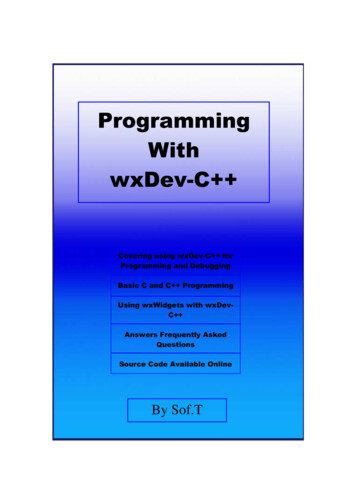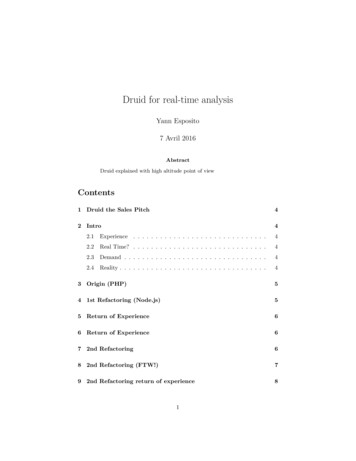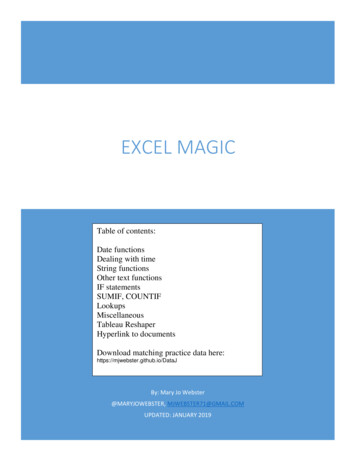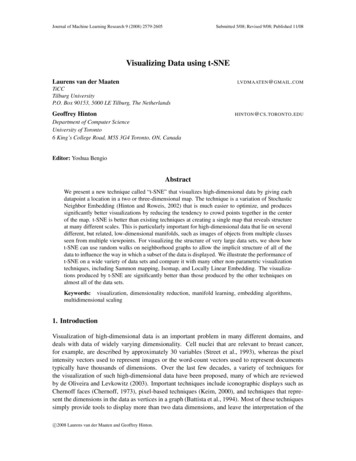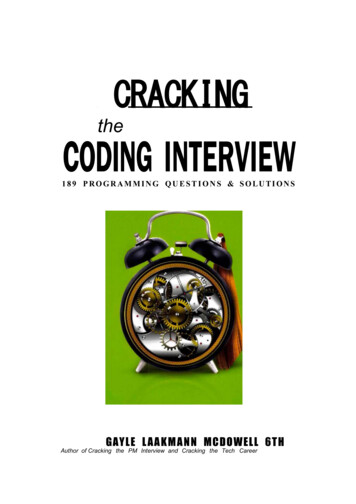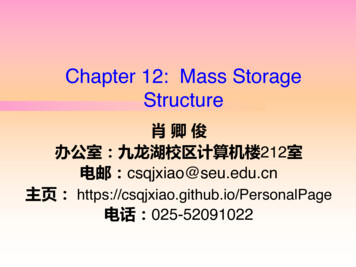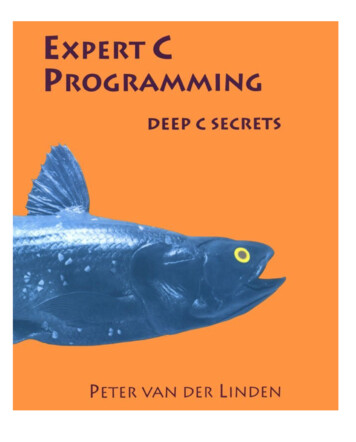
Transcription
Expert C Programming: Deep C SecretsBy Peter van der LindenIntroductionC code. C code run. Run code run please!—Barbara LingAll C programs do the same thing: look at a character and do nothing with it.—Peter WeinbergerHave you ever noticed that there are plenty of C books with suggestive names like C Traps andPitfalls, or The C Puzzle Book, or Obfuscated C and Other Mysteries, but other programminglanguages don't have books like that? There's a very good reason for this!C programming is a craft that takes years to perfect. A reasonably sharp person can learn the basics ofC quite quickly. But it takes much longer to master the nuances of the language and to write enoughprograms, and enough different programs, to become an expert. In natural language terms, this is thedifference between being able to order a cup of coffee in Paris, and (on the Metro) being able to tell anative Parisienne where to get off. This book is an advanced text on the ANSI C programminglanguage. It is intended for people who are already writing C programs, and who want to quickly pickup some of the insights and techniques of experts.Expert programmers build up a tool kit of techniques over the years; a grab-bag of idioms, codefragments, and deft skills. These are acquired slowly over time, learned from looking over theshoulders of more experienced colleagues, either directly or while maintaining code written by others.Other lessons in C are self-taught. Almost every beginning C programmer independently rediscoversthe mistake of writing:if (i 3)instead of:if (i 3)Once experienced, this painful error (doing an assignment where comparison was intended) is rarelyrepeated. Some programmers have developed the habit of writing the literal first, like this: if(3 i). Then, if an equal sign is accidentally left out, the compiler will complain about an"attempted assignment to literal." This won't protect you when comparing two variables, but everylittle bit helps.
The 20 Million BugIn Spring 1993, in the Operating System development group at SunSoft, we had a "priority one" bugreport come in describing a problem in the asynchronous I/O library. The bug was holding up the saleof 20 million worth of hardware to a customer who specifically needed the library functionality, sowe were extremely motivated to find it. After some intensive debugging sessions, the problem wasfinally traced to a statement that read :x 2;It was a typo for what was intended to be an assignment statement. The programmer 's finger hadbounced on the "equals" key, accidentally pressing it twice instead of once. The statement as writtencompared x to 2, generated true or false, and discarded the result .C is enough of an expression language that the compiler did not complain about a statement whichevaluated an expression, had no side-effects, and simply threw away the result. We didn't knowwhether to bless our good fortune at locating the problem, or cry with frustration at such a commontyping error causing such an expensive problem. Some versions of the lint program would havedetected this problem, but it's all too easy to avoid the automatic use of this essential tool.This book gathers together many other salutary stories. It records the wisdom of many experiencedprogrammers, to save the reader from having to rediscover everything independently. It acts as a guidefor territory that, while broadly familiar, still has some unexplored corners. There are extendeddiscussions of major topics like declarations and arrays/pointers, along with a great many hints andmnemonics. The terminology of ANSI C is used throughout, along with translations into ordinaryEnglish where needed.Programming ChallengeORHandy Heuristic
Sample BoxAlong the way, we have Programming Challenges outlined in boxes like this one.These are suggestions for programs that you should write.There are also Handy Heuristics in boxes of their own.These are ideas, rules-of-thumb, or guidelines that work in practice. You can adopt them asyour own. Or you can ignore them if you already have your own guidelines that you likebetter.ConventionOne convention that we have is to use the names of fruits and vegetables for variables (only in smallcode fragments, not in any real program, of course):char pear[40];double peach;int mango 13;long melon 2001;This makes it easy to tell what's a C reserved word, and what's a name the programmer supplied.Some people say that you can't compare apples and oranges, but why not—they are both hand-heldround edible things that grow on trees. Once you get used to it, the fruit loops really seem to help.There is one other convention—sometimes we repeat a key point to emphasize it. In addition, wesometimes repeat a key point to emphasize it.Like a gourmet recipe book, Expert C Programming has a collection of tasty morsels ready for thereader to sample. Each chapter is divided into related but self-contained sections; it's equally easy toread the book serially from start to finish, or to dip into it at random and review an individual topic atlength. The technical details are sprinkled with many true stories of how C programming works inpractice. Humor is an important technique for mastering new material, so each chapter ends with a"light relief" section containing an amusing C story or piece of software folklore to give the reader achange of pace.Readers can use this book as a source of ideas, as a collection of C tips and idioms, or simply to learnmore about ANSI C, from an experienced compiler writer. In sum, this book has a collection of usefulideas to help you master the fine art of ANSI C. It gathers all the information, hints, and guidelinestogether in one place and presents them for your enjoyment. So grab the back of an envelope, pull outyour lucky coding pencil, settle back at a comfy terminal, and let the fun begin!Some Light Relief—Tuning File SystemsSome aspects of C and UNIX are occasionally quite lighthearted. There's nothing wrong with wellplaced whimsy. The IBM/Motorola/Apple PowerPC architecture has an E.I.E.I.O. instruction [1] thatstands for "Enforce In-order Execution of I/O". In a similar spirit, there is a UNIX command,
tunefs, that sophisticated system administrators use to change the dynamic parameters of afilesystem and improve the block layout on disk.[1]Probably designed by some old farmer named McDonald.The on-line manual pages of the original tunefs, like all Berkeley commands, ended with a "Bugs"section. In this case, it read:Bugs:This program should work on mounted and active file systems,but it doesn't. Because the superblock is not kept in thebuffer cache, the program will only take effect if it is runon dismounted file systems; if run on the root file system,the system must be rebooted. You can tune a file system, butyou can't tune a fish.Even better, the word-processor source had a comment in it, threatening anyone who removed that lastphrase! It said:Take this out and a UNIX Demon will dog your steps from nowuntil the time t's wrap around.When Sun, along with the rest of the world, changed to SVr4 UNIX, we lost this gem. The SVr4manpages don't have a "Bugs" section—they renamed it "Notes" (does that fool anyone?). The "tunafish" phrase disappeared, and the guilty party is probably being dogged by a UNIX demon to this day.Preferably lpd.Programming ChallengeComputer DatingWhen will the time t's wrap around?Write a program to find out.1. Look at the definition of time t. This is in file /usr/include/time.h.2. Code a program to place the highest value into a variable of type time t, thenpass it to ctime() to convert it into an ASCII string. Print the string. Note thatctime has nothing to do with the language C, it just means "convert time."
For how many years into the future does the anonymous technical writer who removed thecomment have to worry about being dogged by a UNIX daemon? Amend your program tofind out.1. Obtain the current time by calling time().2. Call difftime() to obtain the number of seconds between now and the highestvalue of time t.3. Format that value into years, months, weeks, days, hours, and minutes. Print it.Is it longer than your expected lifetime?Programming SolutionComputer DatingThe results of this exercise will vary between PCs and UNIX systems, and will depend onthe way time t is stored. On Sun systems, this is just a typedef for long. Our first attemptedsolution is#include stdio.h #include time.h int main() {time t biggest 0x7FFFFFFF;printf("biggest %s \n", ctime(&biggest) );return 0;}This gives a result of:biggest Mon Jan 18 19:14:07 2038However, this is not the correct answer! The function ctime() converts its argument intolocal time, which will vary from Coordinated Universal Time (also known as GreenwichMean Time), depending on where you are on the globe. California, where this book waswritten, is eight hours behind London, and several years ahead.We should really use the gmtime() function to obtain the largest UTC time value. Thisfunction doesn't return a printable string, so we call asctime()to get this. Putting it all
together, our revised program is#include stdio.h #include time.h int main() {time t biggest 0x7FFFFFFF;}printf("biggest %s \n", asctime(gmtime(&biggest)) );return 0;This gives a result of:biggest Tue Jan 19 03:14:07 2038There! Squeezed another eight hours out of it!But we're still not done. If you use the locale for New Zealand, you can get 13 more hours,assuming they use daylight savings time in the year 2038. They are on DST in Januarybecause they are in the southern hemisphere. New Zealand, because of its easternmostposition with respect to time zones, holds the unhappy distinction of being the first countryto encounter bugs triggered by particular dates.Even simple-looking things can sometimes have a surprising twist in software. And anyonewho thinks programming dates is easy to get right the first time probably hasn't done muchof it.Chapter 1. C Through the Mists of TimeC is quirky, flawed, and an enormous success.—Dennis Ritchiethe prehistory of C the golden rule for compiler-writers early experiences with C the standardI/O library and C preprocessor K&R C the present day: ANSI C it's nice, but is it standard? thestructure of the ANSI C standard reading the ANSI C standard for fun, pleasure, and profit howquiet is a "quiet change"? some light relief—the implementation-defined effects of pragmasThe Prehistory of CThe story of C begins, paradoxically, with a failure. In 1969 the great Multics project—a joint venturebetween General Electric, MIT, and Bell Laboratories to build an operating system—was clearly introuble. It was not only failing to deliver the promised fast and convenient on-line system, it wasfailing to deliver anything usable at all. Though the development team eventually got Multics creakinginto action, they had fallen into the same tarpit that caught IBM with OS/360. They were trying tocreate an operating system that was much too big and to do it on hardware that was much too small.
Multics is a treasure house of solved engineering problems, but it also paved the way for C to showthat small is beautiful.As the disenchanted Bell Labs staff withdrew from the Multics project, they looked around for othertasks. One researcher, Ken Thompson, was keen to work on another operating system, and madeseveral proposals (all declined) to Bell management. While waiting on official approval, Thompsonand co-worker Dennis Ritchie amused themselves porting Thompson's "Space Travel" software to alittle-used PDP-7. Space Travel simulated the major bodies of the solar system, and displayed them ona graphics screen along with a space craft that could be piloted and landed on the various planets. Atthe same time, Thompson worked intensively on providing the PDP-7 with the rudiments of a newoperating system, much simpler and lighter-weight than Multics. Everything was written in assemblerlanguage. Brian Kernighan coined the name "UNIX" in 1970, paro-dying the lessons now learnedfrom Multics on what not to do. Figure 1-1 charts early C, UNIX, and associated hardware.Figure 1-1. Early C, UNIX, and Associated HardwareIn this potential chicken-and-egg situation, UNIX definitely came well before C (and it's also whyUNIX system time is measured in seconds since January 1, 1970—that's when time began). However,this is the story not of poultry, but of programming. Writing in assembler proved awkward; it tooklonger to code data structures, and it was harder to debug and understand. Thompson wanted theadvantages of a high-level implementation language, but without the PL/I [1] performance andcomplexity problems that he had seen on Multics. After a brief and unsuccessful flirtation withFortran, Thompson created the language B by simplifying the research language BCPL [2] so itsinterpreter would fit in the PDP-7's 8K word memory. B was never really successful; the hardwarememory limits only provided room for an interpreter, not a compiler. The resulting slow performanceprevented B from being used for systems programming of UNIX itself.[1]The difficulties involved in learning, using, and implementing PL/I led one programmer to pen this verse:IBM had a PL/I / Its syntax worse than JOSS / And everywhere this language went / It was a total loss.JOSS was an earlier language, also not noted for simplicity.[2]"BCPL: A Tool for Compiler Writing and System Programming," Martin Richards, Proc. AFIPS Spring JointComputer Conference, 34 (1969), pp. 557-566. BCPL is not an acronym for the "Before C Programming
Language", though the name is a happy coincidence. It is the "Basic Combined Programming Lan-guage"—"basic" in the sense of "no frills"—and it was developed by a combined effort of researchers at LondonUniversity and Cambridge University in England. A BCPL implementation was available on Multics.Software DogmaThe Golden Rule of Compiler-Writers:Performance Is (almost) Everything.Performance is almost
"light relief" section containing an amusing C story or piece of software folklore to give the reader a change of pace. Readers can use this book as a source of ideas, as a collection of C tips and idioms, or simply to learn more about ANSI C, from an experienced compiler writer. In sum, this book has a collection of useful ideas to help you master the fine art of ANSI C. It gathers all the .

